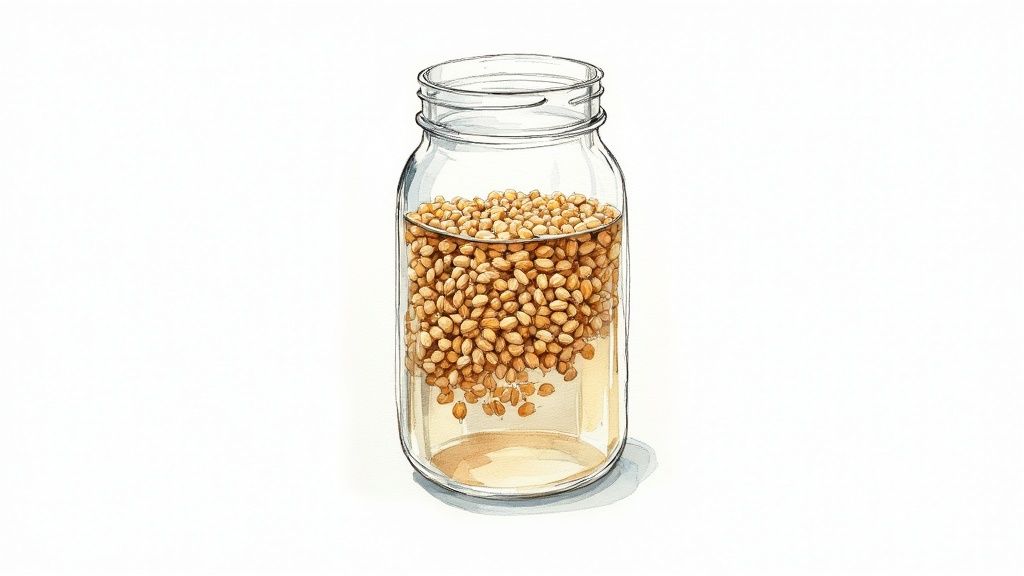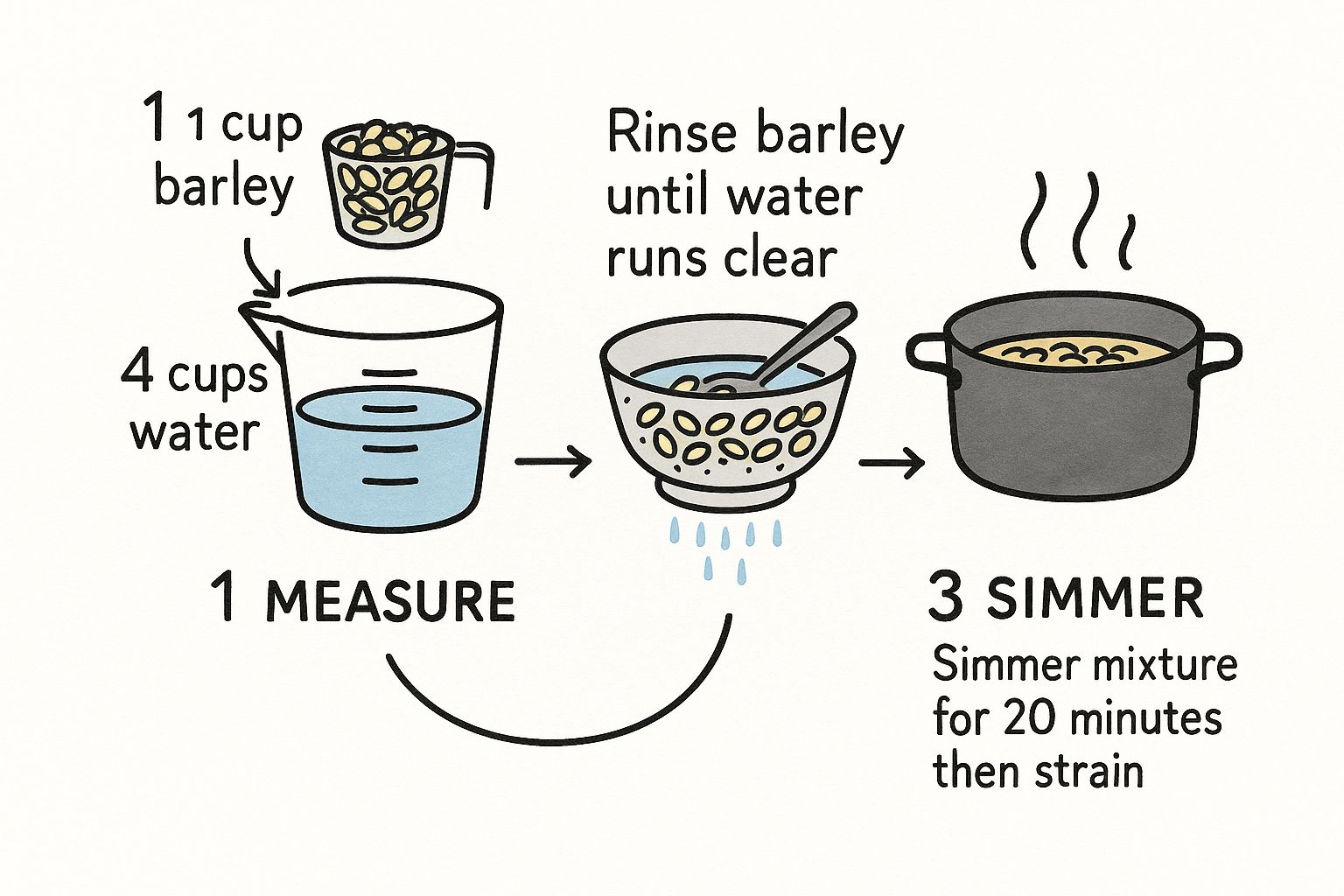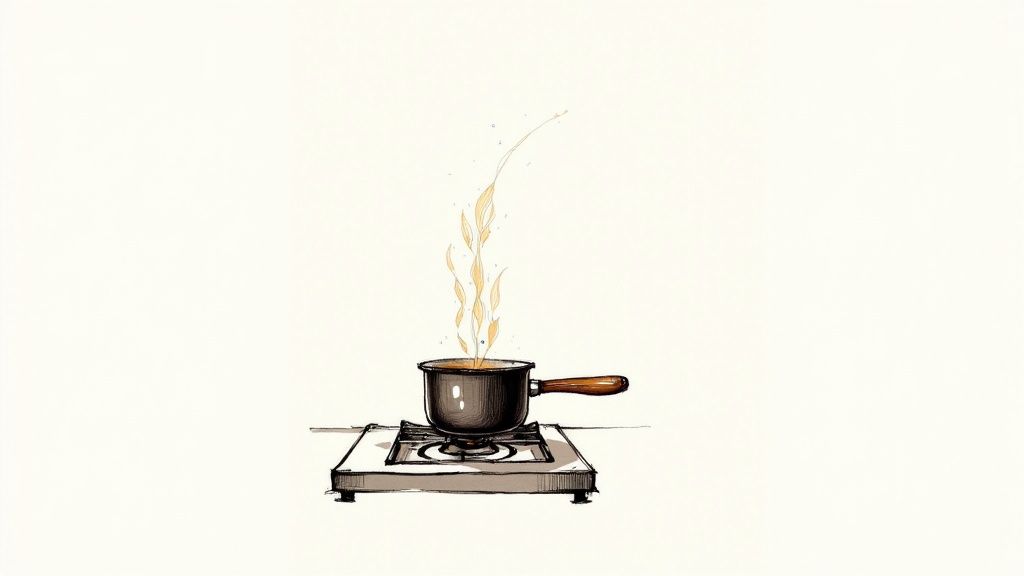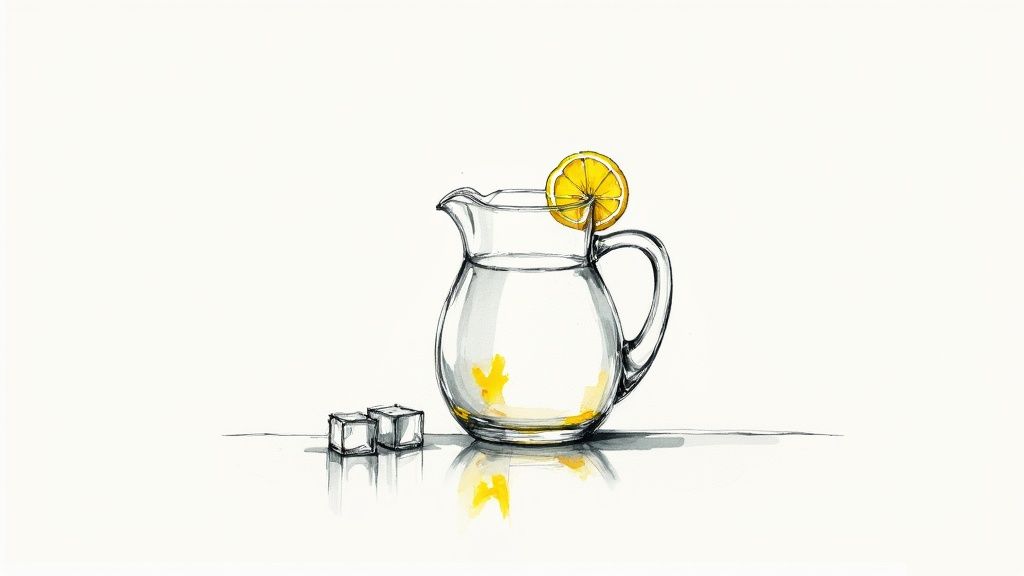How to Make Barley Water an Easy Refreshing Drink
Learn how to make barley water with our simple, refreshing recipe. Discover flavor variations, health benefits, and tips for this easy homemade drink.
Posted by
Making barley water is wonderfully simple. It's just simmering barley grains in water until they release their mild, nutty flavor, then straining them out. What you're left with is a soothing, refreshing drink that people have enjoyed for centuries, long before it became a wellness trend. It's a great alternative when you're tired of plain water!
What Exactly Is Barley Water

If you're ever feeling stuck in a hydration rut, barley water could be the perfect change of pace. Think of it as the original infused water—a gentle, wholesome drink made from just two ingredients: barley and water. It’s not a juice or a tea, but something uniquely its own with a subtle, comforting taste.
This drink is anything but new. Its roots stretch back to ancient times in places like Asia and the Mediterranean, where barley was a staple grain. Its lasting appeal comes from its simplicity. The process is straightforward: gently boil the grains, letting their nutrients and mild flavor seep into the liquid. It's no wonder barley remains such a cornerstone of global agriculture. You can dive deeper into the history of barley production on haifa-group.com.
Why It Fits a Mindful Lifestyle
Making your own barley water is a small, easy step toward being more mindful about what you consume. It’s about knowing exactly what’s in your glass—no added sugars, preservatives, or mystery ingredients.
This approach lines up perfectly with the idea of casual nutrition tracking. You don't need to be rigid; you just need to be aware. Making simple swaps or additions, like a glass of homemade barley water, is a fantastic way to build healthier habits that stick.
The goal is to feel good about your choices without the stress of perfection. Knowing what you're putting into your body—whether it's your morning coffee or a homemade drink—is the first step.
Logging what you eat and drink should be just as easy. Instead of fussing with complicated apps, you can just tell munchlog.ai, "I had a glass of homemade barley water," and let the AI handle the rest. It’s all about making wellness feel less like a chore and more like a natural part of your day.
The Simple No-Fuss Barley Water Recipe
Ready to make your first batch? I promise, learning how to make barley water is one of the easiest kitchen projects you'll ever tackle. It’s really just barley, water, and a little bit of time. You're basically creating a blank canvas for a wonderfully refreshing drink that you can flavor however you like.
The whole process boils down to three simple actions: rinse the grains, simmer them in water, and strain the liquid. That's it. Let’s get into the specifics so you can do it perfectly the first time.
Choosing Your Barley
First up, you need to grab your barley. When you're at the store, you'll likely see two main options: pearl barley and hulled barley. They might look pretty similar, but they'll give your water a different character.
- Pearl Barley: This is what most people use, and it's what I recommend starting with. The outer husk and bran are polished off, so it cooks faster. The result is a much lighter, milder-tasting water with a clean, subtle flavor.
- Hulled Barley: Think of this as the whole-grain version. Only the toughest outer layer is removed, leaving more of the good stuff. It's chewier and has a nuttier, earthier flavor, which definitely comes through in the final drink.
To help you decide, here’s a quick comparison.
Hulled vs Pearl Barley Quick Guide
This simple table breaks down the main differences to help you choose the right barley for the kind of water you want to make.
| Feature | Hulled Barley | Pearl Barley |
|---|---|---|
| Processing | Minimally processed; bran intact | Polished; bran and husk removed |
| Cook Time | Longer (40-50 mins) | Shorter (20-30 mins) |
| Flavor | Nutty, earthy, more robust | Mild, light, subtle |
| Nutrients | Higher in fiber and nutrients | Lower in fiber and nutrients |
| Best For | A more flavorful, nutrient-dense drink | A light, classic, and quick recipe |
Ultimately, there’s no wrong choice! It just comes down to personal preference. If you want a quick and light-tasting drink, go for pearl barley. If you're after more nutrients and a deeper flavor, hulled is the way to go.
The Basic Steps
Here’s a great visual that sums up just how easy this is.

The core method is all about the ratio and a gentle simmer.
Start by measuring out 1 cup of barley and giving it a really good rinse under cold, running water. I use a fine-mesh sieve for this. This step is crucial because it gets rid of any dust and extra starch, which is the secret to getting crystal-clear barley water instead of a cloudy brew.
Next, toss the rinsed barley into a saucepan with 4 cups of water. Bring it all to a rolling boil, then immediately turn the heat down to low and let it simmer away gently for about 20-25 minutes. You’ll see the water take on a slightly milky color and the grains will be plump and soft.
Finally, carefully strain the liquid into a pitcher or a large jar, leaving the cooked grains behind. And you're done!
A quick tip from my kitchen: don't throw away those leftover barley grains! They're packed with fiber and have a wonderful, chewy texture. I love adding them to soups, salads, or even a vegetable stir-fry for a little extra substance. It’s an easy way to prevent food waste.
Once your barley water is ready, logging it is just as simple. You can just tell munchlog.ai, “I had a glass of homemade barley water.” It’s a super low-effort way to track your hydration without getting bogged down in manual data entry.
Why Add Barley Water to Your Daily Routine

So, you’ve made a fresh batch of barley water and it's cooling in the fridge. Now what? Let's be clear—it's not a miracle cure for anything, but it’s a genuinely fantastic and simple way to boost your daily hydration.
Think of it as water with perks. It's the perfect answer for those moments when you're bored with plain water but want to skip the sugar and caffeine found in most juices, sodas, and energy drinks. Its subtle, nutty flavor is incredibly refreshing, especially on a hot day or after a workout.
More Than Just Hydation (But Still Simple!)
What makes barley water interesting is its soluble fiber content. When barley is simmered, some of this fiber is released into the water. It’s a small, gentle way to support healthy digestion without overthinking it.
This is a great example of mindful eating in action. Simply being aware of what you’re putting into your body—whether it's the fiber in your barley water or the protein in your lunch—is a step towards a more balanced lifestyle. It's an easy, healthy habit to pick up.
When you can track what you eat and drink just by talking, it stops feeling like a chore. Just say, "I had barley water with lemon," and munchlog.ai takes care of the rest.
A Growing Trend for Good Reason
There's a reason this humble drink is making a comeback. People are looking for natural, low-calorie drinks that feel good to drink.
As a whole grain, barley provides a steady, slow release of energy because it's a complex carb. You can learn more about how this works in our guide to what complex carbohydrates are. Ultimately, barley water is just a satisfying way to hydrate.
Playing with Flavor: How to Customize Your Barley Water
Plain barley water is great on its own, but the real fun starts when you customize it. Think of the basic, nutty brew as your blank canvas. A few simple additions can take it from a humble hydrator to a genuinely delicious drink.
What I love most is how easy it is. You don't need any fancy techniques. Just toss your flavorings right into the pot while the barley is simmering, and their essence will infuse beautifully into the water. This creates a much deeper, more aromatic drink than just adding them at the end.
Simple Flavor Ideas to Get You Started
Not sure where to begin? Here are a few of my go-to combinations. They’re foolproof and really deliver on flavor.
- Lemon & Mint Cooler: Add a few sprigs of fresh mint and a couple of thick lemon slices to the pot while it simmers. The result is incredibly refreshing, an absolute lifesaver on a hot day.
- Warming Ginger & Spice: Toss in a few slices of fresh ginger and a whole cinnamon stick. This version is so cozy and warming, perfect for a chilly evening when you need something to soothe you.
- Sweet & Zesty Citrus: For a touch of natural sweetness, stir in a spoonful of honey or maple syrup after you've strained the warm water. A squeeze of fresh orange or lime juice at the end adds a fantastic bright kick.
You can also get creative with other things, like a handful of crushed berries. If you're curious about which fruits pack the best punch, our guide to the nutrition facts of mixed berries has some great info.
Keep Track of Your Creations—The Easy Way
Once you’ve perfected your signature blend, tracking it shouldn't be a chore. This is where a more relaxed approach to logging comes in handy. Instead of meticulously entering every single ingredient, you can just describe what you made.
The point is to make mindful eating feel creative, not clinical. Experimenting with flavors should be fun, and logging it should be just as effortless.
For instance, you can simply tell munchlog.ai, “I had a glass of barley water with ginger and honey.” The AI is smart enough to break that down and figure out the nutrition for you. It’s a seamless way to stay aware of what you're consuming—calories, carbs, and all—without pulling you out of your creative zone in the kitchen. That way, you can just focus on enjoying your delicious new drink.
Tips, Tricks, and Common Questions

Alright, let's get into a few practical tips and common questions that always come up when making barley water for the first time. Getting these details right will help you perfect your brew and make it a regular habit.
A question I hear all the time is, "Why does my barley water look so cloudy?" Don't worry, that's completely normal and actually a good sign! The cloudiness comes from the starches releasing from the barley grains, which is exactly what gives the drink its soothing, silky texture. If you want it a bit clearer, just give the grains an extra good rinse before you start cooking.
Storing Your Barley Water
As for storage, homemade barley water is definitely best when it's fresh. But you can absolutely keep it in an airtight jar or bottle in the fridge for up to three days. You might notice it separates a little as it sits—just give it a good shake or stir before you pour.
And whatever you do, don't throw out the leftover cooked barley! Those grains are packed with fiber and are incredibly versatile.
- Toss them into a simmering soup or stew to add body and nutrients.
- Mix them into a salad for a fantastic, chewy texture.
- Stir a spoonful into your morning oatmeal for an extra boost of whole grains.
It's a great way to cut down on food waste and get the most out of your ingredients. Little habits like this, even just being more mindful of what you eat, can make a big difference in a healthier lifestyle.
A Quick Note on Portions
If you're tracking your intake and decide to add a cup of that cooked barley to another dish, it's easy to log. If you're curious about managing portion sizes without getting overwhelmed, our article on using a food scale for weight loss has some great, no-fuss advice.
It's no surprise that drinks like this are gaining traction. The global barley market is actually projected to reach USD 32.5 billion by 2033, and a big part of that growth is its increasing use in healthy beverages. You can read more about the growing barley market trends on imarcgroup.com.
Got Questions About Barley Water? We’ve Got Answers
If you still have a few things you're wondering about, you're not alone. Here are the answers to some of the most common questions people ask when they first start making barley water.
Can I Just Use Barley Flour Instead?
You could, but you won't get the light, refreshing drink you're probably picturing. Using barley flour creates a much thicker, almost soupy consistency because you're mixing the entire ground grain into the water, rather than just infusing it.
For that classic, clear barley water, you really need to use the whole grains—either pearl or hulled—and then strain them out after simmering.
Hulled vs. Pearl Barley Water: What’s the Taste Difference?
The difference in taste is pretty noticeable once you've tried both. Water made from hulled barley has a much deeper, nuttier, and more earthy flavor since it's the whole, unprocessed grain.
On the other hand, pearl barley (which has the outer bran polished off) results in a lighter, cleaner, and much milder drink. If you're new to barley water, I'd suggest starting with pearl barley; its delicate taste is often more approachable.
At the end of the day, it's all down to your personal taste. There isn't a "better" option, just a choice between a more robust flavor or a subtler one.
Is It Okay to Drink Barley Water Every Single Day?
For most healthy adults, absolutely. Having a glass of barley water each day can be a great addition to your routine and a fantastic way to stay hydrated. It’s a very gentle, natural drink.
Of course, like with anything, moderation is smart. The best rule of thumb is simply to listen to your body.
And if you're keeping track of what you eat and drink, it's easy to log. Just tell your app, "I had one glass of barley water," and you're done.
Ready to make tracking your new healthy habits as simple as making this recipe? munchlog.ai lets you log your food and drinks just by talking. No typing, no photos, no stress. Give it a try and see how easy mindful eating can be at https://munchlog.ai.